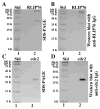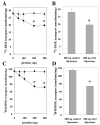Increased expression of cdc2 inhibits transport function of RLIP76 and promotes apoptosis
- PMID: 19375851
- PMCID: PMC2721022
- DOI: 10.1016/j.canlet.2009.03.033
Increased expression of cdc2 inhibits transport function of RLIP76 and promotes apoptosis
Abstract
RLIP76 is a stress-responsive glutathione-electrophile-conjugates (GS-E) and drugs transporter which is over-expressed in different types of cancers. Cdc2 is a cell-cycle check point control kinase which has been shown to bind to RLIP76 during mitosis, such that endocytosis is inhibited. In present studies, we have purified cdc2 and examined its effect on the transport activity of RLIP76 reconstituted into artificial liposomes. Both doxorubicin (DOX) and dinitro-phenyl S-glutathione (DNP-SG) transport were inhibited by cdc2 in a concentration dependent manner. Liposomal delivery of cdc2 to H358 cells caused apoptosis, resulted in an increased intracellular doxorubicin-accumulation and decreased rate of efflux from the cells. In the present communication, we propose that the accumulation-deficient drug-resistance mediated by RLIP76 can be modulated by inhibition of RLIP76 transport activity by cdc2.
Conflict of interest statement
Figures




Similar articles
-
POB1 over-expression inhibits RLIP76-mediated transport of glutathione-conjugates, drugs and promotes apoptosis.Biochem Biophys Res Commun. 2005 Mar 25;328(4):1003-9. doi: 10.1016/j.bbrc.2005.01.055. Biochem Biophys Res Commun. 2005. PMID: 15707977
-
Novel function of human RLIP76: ATP-dependent transport of glutathione conjugates and doxorubicin.Biochemistry. 2000 Aug 8;39(31):9327-34. doi: 10.1021/bi992964c. Biochemistry. 2000. PMID: 10924126
-
RLIP76 is the major ATP-dependent transporter of glutathione-conjugates and doxorubicin in human erythrocytes.Arch Biochem Biophys. 2001 Jul 15;391(2):171-9. doi: 10.1006/abbi.2001.2395. Arch Biochem Biophys. 2001. PMID: 11437348
-
The non-ABC drug transporter RLIP76 (RALBP-1) plays a major role in the mechanisms of drug resistance.Curr Drug Metab. 2007 May;8(4):315-23. doi: 10.2174/138920007780655414. Curr Drug Metab. 2007. PMID: 17504221 Review.
-
RLIP76: A novel glutathione-conjugate and multi-drug transporter.Biochem Pharmacol. 2009 Mar 1;77(5):761-9. doi: 10.1016/j.bcp.2008.10.006. Epub 2008 Oct 15. Biochem Pharmacol. 2009. PMID: 18983828 Free PMC article. Review.
Cited by
-
Knockdown of RLIP76 expression by RNA interference inhibits invasion, induces cell cycle arrest, and increases chemosensitivity to the anticancer drug temozolomide in glioma cells.J Neurooncol. 2013 Mar;112(1):73-82. doi: 10.1007/s11060-013-1045-2. Epub 2013 Jan 6. J Neurooncol. 2013. PMID: 23292182
-
Overexpression of RalBP1 in colorectal cancer is an independent predictor of poor survival and early tumor relapse.Cancer Biol Ther. 2012 Jun;13(8):694-700. doi: 10.4161/cbt.20087. Epub 2012 Jun 1. Cancer Biol Ther. 2012. PMID: 22549157 Free PMC article.
-
RLIP76 Inhibition: A Promising Developmental Therapy for Neuroblastoma.Pharm Res. 2017 Aug;34(8):1673-1682. doi: 10.1007/s11095-017-2154-y. Epub 2017 Apr 6. Pharm Res. 2017. PMID: 28386633 Review.
-
RLIP76: a versatile transporter and an emerging target for cancer therapy.Biochem Pharmacol. 2010 Jun 15;79(12):1699-705. doi: 10.1016/j.bcp.2010.01.016. Epub 2010 Jan 25. Biochem Pharmacol. 2010. PMID: 20097178 Free PMC article. Review.
-
Knockdown of CDC2 expression inhibits proliferation, enhances apoptosis, and increases chemosensitivity to temozolomide in glioblastoma cells.Med Oncol. 2015 Jan;32(1):378. doi: 10.1007/s12032-014-0378-9. Epub 2014 Nov 30. Med Oncol. 2015. PMID: 25433945
References
-
- Galimberti S, Testi R, Guerrini F, Fazzi R, Petrini M. The clinical relevance of the expression of several multidrug-resistant-related genes in patients with primary acute myeloid leukemia. J Chemother. 2003;15:374–379. - PubMed
-
- Kourti M, Vavatsi N, Gombakis N, Sidi V, Tzimagiorgis G, Papageorgiou T, Koliouskas D, Athanassiadou F. Expression of multidrug resistance 1 (MDR1), multidrug resistance-related protein 1 (MRP1), lung resistance protein (LRP), and breast cancer resistance protein (BCRP) genes and clinical outcome in childhood acute lymphoblastic leukemia. Int J Hematol. 2007;86:166–173. - PubMed
-
- Jullien-Flores V, Dorseuil O, Romero F, Letourneur F, Saragosti S, Berger R, Tavitian A, Gacon G, Camonis JH. Bridging Ral GTPase to Rho pathways. RLIP76, a Ral effector with CDC42/Rac GTPase-activating protein activity. J Biol Chem. 1995;270:22473–22477. - PubMed
-
- Park SH, Weinberg RA. A putative effector of Ral has homology to Rho/Rac GTPase-activating proteins. Oncogene. 1995;11:2349–2355. - PubMed
Publication types
MeSH terms
Substances
Grants and funding
LinkOut - more resources
Full Text Sources
Miscellaneous

